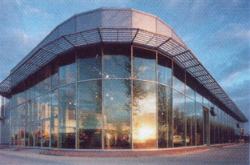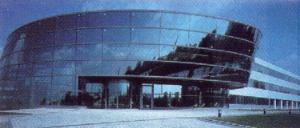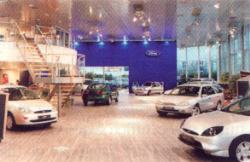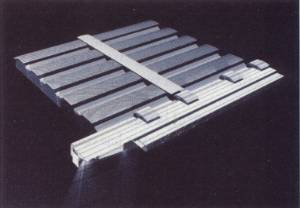E |
xactly one year ago, the future looked bleak for Ford Motor Company’s European operations. Bleeding red ink by the buckets, plagued by under-utilized plant capacity and struggling to maintain market share, Ford Europe was more than stuck in reverse. It was careening out of control.
a 44,530-sq.-m. (480,000-sq.-ft.) clean-room facility for the manufacture of a new, high-technology diesel engine.
Even as the European automotive industry enjoyed record sales, Ford Europe lost US$1.1 billion in 2000. Even worse, in three years Ford Europe had seen its market share plunge five full percentage points to just 8.3 percent of the European market. The mounting setbacks prompted analysts on Wall Street and auto industry experts to sour on Ford Europe’s prospects for a comeback.
The analysts and experts were premature.
By June 2001, then-chair of Ford Europe Nick Scheele had engineered one of the most amazing turnarounds in the auto industry’s history. Ford Europe reported first-quarter profits of $88 million on sales of $8.7 billion. Ford’s market share on the continent — not counting its luxury brands Volvo, Jaguar, Aston Martin and Land Rover — increased to 9.1 percent in the first four months of the year, up from 8.6 percent in the same period in 2000.
Ford’s $20,000 Mondeo sedan, introduced in late 2000, was named “best in its class” by the respected Auto Motor und Sport, a European publication covering the car industry. And sales of the Ford Focus, a $15,000 compact introduced in 1998, increased markedly as European consumers flocked to the fuel-friendly but sporty-looking car.
|
The good news from Europe could not come at a better time for the Dearborn, Mich.-based Ford Motor Co. Already faced with plant closings, job layoffs, shrinking market share, recall problems and injury lawsuits in the United States, Ford absorbed another huge blow in September when the terrorist attacks on New York and Washington disrupted supply-chain operations, forcing temporary shutdowns of several plants.
While many observers have credited Scheele’s $1 billion restructuring program with turning around Ford Europe, scant attention has been paid to the people who are making it happen: the corporate real estate leaders, site selectors and plant managers who are launching new facilities and scrapping Ford’s old ways of building cars in Europe.
Cologne:
The Model for Ford Europe
The turnaround model for Ford Europe can be found in Cologne, Germany, and not just because that’s the company’s headquarters. Ford is completely renovating its car plant in Cologne and remaking it into one of the most modern automotive manufacturing facilities in the world.
Ford will invest more than $500 million into the Cologne plant to overhaul the production processes for the new Ford Fiesta, which will start rolling off the assembly line by the end of this month. Another $60 million is being spent on infrastructure in a new supplier park, linked to the Cologne plant by a conveyor system. About 1,000 jobs will be created at the park.
“After its renovation, the Ford plant in Cologne will be one of the most modern automotive production facilities in Europe,” says David Thursfield, president and CEO of Ford Europe. “We will also be the leader in flexibility, enabling us to respond quickly to customer needs.”
The idea behind the revamped Ford plant in Cologne is to use virtual and Internet-based systems to optimize the linkages between dealers, suppliers and the factory. The plant also will establish new standards in body production with the introduction of fully flexible equipment, including Europe’s fastest sheet metal press and the first forklift-free assembly area in the auto industry.
Another innovative concept involves the way Ford compensates suppliers. A new “pay on production” concept allows equipment suppliers to retain ownership of the machinery. Instead of Ford buying the machines, the automaker pays the suppliers on a unit output basis — freeing up needed investment capital for Ford while giving suppliers a financial stake in boosting plant productivity.
The maximum daily capacity at the Cologne plant will increase by 45 percent to 1,800 vehicles, with annual capacity rising to a maximum of 405,000 units. The increase is due to improved efficiency through plant modernization, as well as the addition of a third shift.
But Ford Europe isn’t confining its modernization program to Cologne. Across the continent, the company is working on at least 10 other major plant projects this year, ranging from the recently opened $450 million Jaguar plant in Merseyside to a $2 million design center in London (please see accompanying chart).
Jay Gardner, director of Ford Land Europe, is Ford’s top corporate real estate executive on the continent and is responsible for overseeing the project management teams for every one of these expansions.
“Ford Land focuses on strategy,” says Gardner, based in Cologne. “Our main goals as we pursue these projects are to continue our asset rationalization, reduce our operating costs, improve our customer satisfaction and grow our business. We are selling and disposing of assets we don’t need while providing fully integrated solutions to all of our space needs, whether they be for manufacturing space, office space or R&D.”
The only way Ford Land can do that effectively on so many large-scale projects is to outsource most of the tactical real estate work, says Gardner. “We are trying to get more of the transaction work done by service providers,” he says. “Healey and Baker does our primary transaction work in Europe, and they also do a lot of consulting. M&W Zander Facility Management, based in Stuttgart, Germany, is more involved in our office moves. We handle 7,000 office moves a year for Ford Europe.”
Cost Control is Job No. 1
Healey and Baker has completed the first year of a three-year contract by which the firm serves as Ford Land’s exclusive real estate provider in Europe, the Middle East and Africa. Peter Johnson, a partner in the firm’s corporate services unit, manages the Ford account, which is among the firm’s largest clients. He works onsite at Ford in Warley, Essex, in a building originally meant to be Ford’s European headquarters.
“We have instituted a number of procedures and are working on more in terms of delivering what Ford Land really needs, which is the best real estate service they can get in the shortest possible time at a reasonable price,” says Johnson. “Some things we are doing that we believe will assist them include developing electronic-based instructions, standardizing site research reports and methods of reporting to Ford and putting into place a detailed process manual to be distributed throughout Ford Land and in our various offices.” The latter are intended for real estate consultants, brokers and advisors.
“We are not simply acting as brokers in terms of acquisition or disposing of property,” Johnson adds. “We are multitask firm, and we seek to bring to Ford the full range of services, including acquisition, disposition, rent review and lease renewal, which is the bulk of the work. But we include strategic research advice, valuations, town planning and environmental advice, as well as space planning, rating local property tax, strategic consulting and some balance sheet advice, as well.” Among the specific projects Johnson is working on in is the compilation of property data stemming from Ford’s acquisitions into a new property database.
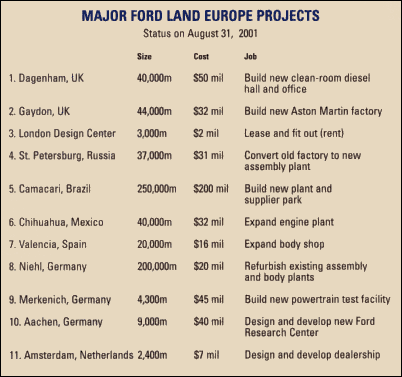
Ford Land could be thought of itself as a service provider, Johnson points out, in so far as it must demonstrate the ability to deliver best-of-class solutions to its diverse constituents. “To various degrees, they act for the various companies within the Ford group,” he explains. “They don’t have an automatic mandate to deal with all their real estate issues. Some divisions pretty much do their own thing property wise, because that’s the way they’ve always done it. Ford Land has to be able to demonstrate that they can add value to a transaction a group like that might do. Consequently, their service provider must do the same.”
Johnson works closely at Ford Land with Andrew Bradshaw, manager of European real estate services at Ford. “We want our service providers to be a partner and a part of our team,” says Bradshaw. “Healey and Baker gives us the flexibility to provide any service in any location, the ability to pull in someone in an obscure part of Europe with an obscure specialty that we wouldn’t have in-house. Our team is comprised of just five real estate managers, and their role is to concentrate more on strategic matters and maintain close relationships with our internal customers.”
Cost containment is at the heart of much of the work Johnson does, a task all organizations are focusing on. “Equally important,” says Bradshaw, “is expansion of businesses and giving them what they need to do that, and consolidation of existing businesses, which allows for operational savings. There is a drive on now to get the best value out of acquisitions we have made by reducing back-room costs. In order to do that, it’s sometimes necessary to put people in the same place physically. Our role is getting that part of the puzzle done.”
Across Europe, a Dizzying Pace
Ford office workers aren’t the only people moving rapidly across the continent. Big build-ups at no fewer than 10 Ford manufacturing sites are creating thousands of new jobs — not to mention new vehicles designed to appeal to a wider range of European consumers.
At Halewood in Merseyside, United Kingdom, Ford executives officially opened the brand-new $450 million plant for the Jaguar X-Type on May 25. The expansion safeguards some 3,000 Ford jobs and creates an additional 500. Aided by $65 million in government incentives from the UK, the plant incorporates the latest in manufacturing technology for a brand name that Scheele helped resurrect years ago.
At Dagenham, UK, Ford is spending $50 million to build a 44,530-sq.-m. clean-room facility for the manufacture of a new, high-technology diesel engine. Roughly the size of seven football fields, the new Diesel Hall will be the first engine plant to combine design and production engineers with manufacturing teams, purchasing and quality-control operators, and support staff all under one roof. The facility also is positioned between the proposed new supplier park and the existing Dagenham Engine Plant, a move that’s designed to improve Ford’s “lean manufacturing” logistics.
In Paris, Ford is partnering with Peugeot Citroen to build the first direct-injection diesel engine under a cooperative agreement. The first phase of the cooperation focuses on designing small, “featherweight” diesel engines offering features and performance never before achieved in engines of this size. Ford and Peugeot unveiled its first such fuel-efficient engine on April 26.
One of Ford Europe’s most ambitious projects, however, was launched earlier this year in Turkey. In Koecaeli, Ford executives opened a $650 million commercial vehicle plant on April 20. The largest investment ever in the Turkish auto industry, the plant is now a joint venture of Ford and Otosan, Ford’s Turkish partner. Production of the commercial truck knows as the Transit began in January, and a second vehicle line — a light van — will be added in mid-2002. Some 4,000 people will be employed at the site 105 kilometers east of Istanbul when the plant reaches full capacity.
“The Kocaeli plant represents a significant strategic investment for Ford Otosan,” Ford Motor Co. President and CEO Jacques Nasser said at the April press conference. “The Turkish market and the surrounding region offers major growth potential, despite short-term economic difficulties.”
Otosan has been manufacturing Ford products in Turkey since 1959, but the new plant represents a significant step forward in Ford’s push to expand market share in southeastern Europe. The total vehicle market in Turkey last year was 643,000 vehicles. Ford sold 42,426 commercial vehicles in Turkey in 2000, representing 23 percent of the commercial market.
In addition to the projects outlined above, Gardner’s group at Ford Land is overseeing large expansion projects in Brazil, Mexico, Spain, Germany, the Netherlands and Russia. The largest of these is a $200 million, 250,000-sq.-m. automotive assembly plant and supplier park in Camacari in northern Brazil.
What Ford Seeks in a Site
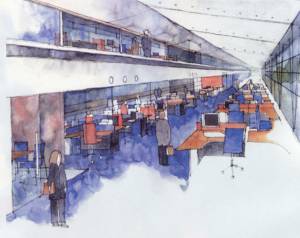 Whether it’s a greenfield site in Brazil or an expansion of an existing facility in the UK, Gardner says his group of site selectors at Ford Land keeps a few critical criteria at the top of the priority list.
Whether it’s a greenfield site in Brazil or an expansion of an existing facility in the UK, Gardner says his group of site selectors at Ford Land keeps a few critical criteria at the top of the priority list.
First and foremost in any site search, he says, is proximity to market. “If you look at the map, we are already located in most of the major European markets,” says Gardner. “We are in Germany, the UK, Spain and Eastern Europe. But we must also consider the price of entry into the market.”
That’s where government incentives come into play — and can make or break a deal, admits Gardner. “For example, in Eastern Europe, we have been successful because the government entities have been willing to waive certain duties and taxes upon our company,” he says. “So government incentives are often pivotal.”

Equally pivotal, he adds, are proximity to a strong labor pool and access to an established base of suppliers. Supplier parks, not normally found in the United States, are quite common in Europe, Gardner notes.
“We just finished a supplier park in Cologne for 20 Ford suppliers,” he says. “We worked very hard at Ford Land to get that property off of our balance sheet. We worked out a deal with the park developer to lease the space to the suppliers. Supplier parks are not new in Europe. In fact, our oldest and largest supplier park is in Valencia, Spain, where Ford is committing $16 million toward a 20,000-sq.-m. body shop expansion. Without that supplier park, this project couldn’t happen.”
Unlike other large Fortune 50 companies that operate site selection teams on a year-round basis, Gardner says that Ford only mobilizes a site search team when the need arises. “Most site searches are conducted by Ford management in Europe,” he notes. “In some cases, if the deal is particularly large, the decision may be made by Jacques Nasser himself or even by the board of directors of Ford.”
What’s next for Ford Europe? Gardner says his new challenge is to integrate the corporate real estate operations of Land Rover and Volvo, two recent Ford acquisitions. Like Jaguar, Land Rover and Volvo represent the crown jewels of the luxury market on the European continent.
If Ford Land can deliver the same real estate solutions to these high-end brands that it has already brought to products such as the Focus and Mondeo, then Ford Europe should continue its robust turnaround.
“Manufacturing is our biggest customer,” says Gardner, “and our main goal is to be viewed as the professional service provider of choice offering premium value for all of our brands.”
